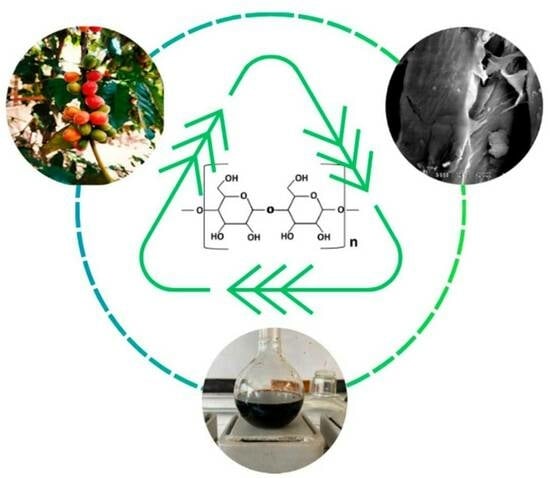Production of Cellulosic Microfibers from Coffee Pulp via Alkaline Treatment, Bleaching and Acid Hydrolysis
Abstract
:1. Introduction
2. Materials and Methods
2.1. Materials
2.2. Physical Treatment
2.3. Proximate Chemical Analysis
2.4. Determination of Lignocellulosic Compounds
2.5. Characterization of Coffee Pulp
2.6. Production of Microcellulosic Fibers
3. Results and Discussion
3.1. PChA of Coffee Pulp
3.2. Characterization of the Coffee Pulp before the Chemical Treatments
3.3. Characterization of the Coffee Pulp after the Chemical Treatments
4. Conclusions
Author Contributions
Funding
Institutional Review Board Statement
Informed Consent Statement
Data Availability Statement
Acknowledgments
Conflicts of Interest
References
- Sharma, A.; Mandal, T.; Goswami, S. Fabrication of cellulose acetate nanocomposite films with lignocelluosic nanofiber filler for superior effect on thermal, mechanical and optical properties. Nano-Struct. Nano-Objects 2021, 25, 100642. [Google Scholar] [CrossRef]
- Kassab, Z.; El Achaby, M.; Tamraoui, Y.; Sehaqui, H.; Bouhfid, R.; Qaiss, A.E.K. Sunflower oil cake-derived cellulose nanocrystals: Extraction, physico-chemical characteristics and potential application. Int. J. Biol. Macromol. 2019, 136, 241–252. [Google Scholar] [CrossRef] [PubMed]
- Baruah, J.; Nath, B.K.; Sharma, R.; Kumar, S.; Deka, R.C.; Baruah, D.C.; Kalita, E. Recent Trends in the Pretreatment of Lignocellulosic Biomass for Value-Added Products. Front. Energy Res. 2018, 6, 141. [Google Scholar] [CrossRef]
- Liu, Y.; Ahmed, S.; Sameen, D.E.; Wang, Y.; Lu, R.; Dai, J.; Li, S.; Qin, W. A review of cellulose and its derivatives in biopolymer-based for food packaging application. Trends Food Sci. Technol. 2021, 112, 532–546. [Google Scholar] [CrossRef]
- Ahola, S.; Salmi, J.; Johansson, L.-S.; Laine, J.; Österberg, M. Model Films from Native Cellulose Nanofibrils. Preparation, Swelling, and Surface Interactions. Biomacromolecules 2008, 9, 1273–1282. [Google Scholar] [CrossRef]
- Sonia, A.; Priya Dasan, K. Celluloses microfibers (CMF)/poly (ethylene-co-vinyl acetate) (EVA) composites for food packaging applications: A study based on barrier and biodegradation behavior. J. Food Eng. 2013, 118, 78–89. [Google Scholar] [CrossRef]
- Kaushik, A.; Singh, M. Isolation and characterization of cellulose nanofibrils from wheat straw using steam explosion coupled with high shear homogenization. Carbohydr. Res. 2011, 346, 76–85. [Google Scholar] [CrossRef]
- Liu, D.; Zhong, T.; Chang, P.R.; Li, K.; Wu, Q. Starch composites reinforced by bamboo cellulosic crystals. Bioresour. Technol. 2010, 101, 2529–2536. [Google Scholar] [CrossRef]
- Manasa, V.; Padmanabhan, A.; Anu Appaiah, K.A. Utilization of coffee pulp waste for rapid recovery of pectin and polyphenols for sustainable material recycle. Waste Manag. 2021, 120, 762–771. [Google Scholar] [CrossRef]
- Rodríguez, D.; Cure, J.R.; Gutierrez, A.P.; Cotes, J.M.; Cantor, F. A coffee agroecosystem model: II. Dynamics of coffee berry borer. Ecol. Model. 2013, 248, 203–214. [Google Scholar] [CrossRef]
- Oberthür, T.; Läderach, P.; Posada, H.; Fisher, M.J.; Samper, L.F.; Illera, J.; Collet, L.; Moreno, E.; Alarcón, R.; Villegas, A.; et al. Regional relationships between inherent coffee quality and growing environment for denomination of origin labels in Nariño and Cauca, Colombia. Food Policy 2011, 36, 783–794. [Google Scholar] [CrossRef]
- Torres-Valenzuela, L.S.; Serna-Jiménez, J.A.; Martínez, K. Coffee By-Products: Nowadays and Perspectives. In Coffee; Dalyse Toledo, C., Ed.; IntechOpen: Rijeka, Croatia, 2019; p. 7. [Google Scholar]
- Collazo-Bigliardi, S.; Ortega-Toro, R.; Chiralt Boix, A. Isolation and characterisation of microcrystalline cellulose and cellulose nanocrystals from coffee husk and comparative study with rice husk. Carbohydr. Polym. 2018, 191, 205–215. [Google Scholar] [CrossRef]
- Trache, D.; Hussin, M.H.; Haafiz, M.K.M.; Thakur, V.K. Recent progress in cellulose nanocrystals: Sources and production. Nanoscale 2017, 9, 1763–1786. [Google Scholar] [CrossRef] [PubMed]
- Jin, E.; Guo, J.; Yang, F.; Zhu, Y.; Song, J.; Jin, Y.; Rojas, O.J. On the polymorphic and morphological changes of cellulose nanocrystals (CNC-I) upon mercerization and conversion to CNC-II. Carbohydr. Polym. 2016, 143, 327–335. [Google Scholar] [CrossRef] [PubMed]
- Scheller, H.V.; Ulvskov, P. Hemicelluloses. Annu. Rev. Plant Biol. 2010, 61, 263–289. [Google Scholar] [CrossRef] [PubMed]
- Omran, A.A.B.; Mohammed, A.A.B.A.; Sapuan, S.M.; Ilyas, R.A.; Asyraf, M.R.M.; Rahimian Koloor, S.S.; Petrů, M. Micro- and Nanocellulose in Polymer Composite Materials: A Review. Polymers 2021, 13, 231. [Google Scholar] [CrossRef]
- Di Donato, P.; Poli, A.; Taurisano, V.; Nicolaus, B. Polysaccharides: Applications in Biology and Biotechnology/Polysaccharides from Bioagro-Waste New Biomolecules-Life. In Polysaccharides: Bioactivity and Biotechnology; Ramawat, K.G., Mérillon, J.-M., Eds.; Springer International Publishing: Cham, Switzerland, 2021; pp. 1–29. [Google Scholar]
- Ten, E.; Vermerris, W. Recent developments in polymers derived from industrial lignin. J. Appl. Polym. Sci. 2015, 132, 42069. [Google Scholar] [CrossRef]
- Weiss, N.; Börjesson, J.; Pedersen, L.S.; Meyer, A.S. Enzymatic lignocellulose hydrolysis: Improved cellulase productivity by insoluble solids recycling. Biotechnol. Biofuels 2013, 6, 5. [Google Scholar] [CrossRef]
- Chundawat, S.P.S.; Beckham, G.T.; Himmel, M.E.; Dale, B.E. Deconstruction of Lignocellulosic Biomass to Fuels and Chemicals. Annu. Rev. Chem. Biomol. Eng. 2011, 2, 121–145. [Google Scholar] [CrossRef]
- Tian, C.; Yi, J.; Wu, Y.; Wu, Q.; Qing, Y.; Wang, L. Preparation of highly charged cellulose nanofibrils using high-pressure homogenization coupled with strong acid hydrolysis pretreatments. Carbohydr. Polym. 2016, 136, 485–492. [Google Scholar] [CrossRef]
- Nakagaito, A.N.; Yano, H. Nanocomposites Based on Cellulose Microfibril. In Cellulose Nanocomposites, American Chemical Society; Kristiina Oksman and Mohini Sain: Washington, DC, USA, 2006; Volume 938, pp. 151–168. [Google Scholar]
- Bahloul, A.; Kassab, Z.; Aziz, F.; Hannache, H.; Bouhfid, R.; Qaiss, A.E.K.; Oumam, M.; El Achaby, M. Characteristics of cellulose microfibers and nanocrystals isolated from doum tree (Chamaerops humilis var. argentea). Cellulose 2021, 28, 4089–4103. [Google Scholar] [CrossRef]
- Soykeabkaew, N.; Laosat, N.; Ngaokla, A.; Yodsuwan, N.; Tunkasiri, T. Reinforcing potential of micro- and nano-sized fibers in the starch-based biocomposites. Compos. Sci. Technol. 2012, 72, 845–852. [Google Scholar] [CrossRef]
- Zhao, D.; Zhu, Y.; Cheng, W.; Chen, W.; Wu, Y.; Yu, H. Cellulose-Based Flexible Functional Materials for Emerging Intelligent Electronics. Adv. Mater. 2021, 33, e2000619. [Google Scholar] [CrossRef] [PubMed]
- Janissen, B.; Huynh, T. Chemical composition and value-adding applications of coffee industry by-products: A review. Resour. Conserv. Recycl. 2018, 128, 110–117. [Google Scholar] [CrossRef]
- Elena, M.; Pardo, S.; Ramos Cassellis, E.; Escobedo, R.M.; García, E.J. Chemical Characterisation of the Industrial Residues of the Pineapple (Ananas comosus). J. Agric. Chem. Environ. 2014, 3, 53–56. [Google Scholar] [CrossRef]
- Horwitz, W.; Latimer, G.W. Official Methods of Analysis of AOAC International, 18th ed.; AOAC International Gaithersburg, Md.: Gaithersburg, MD, USA, 2005. [Google Scholar]
- D1104-56; Method of Test for Holocellulose in Wood. Asociatión Standard Test Methods: West Pittston, PA, USA, 1978.
- D1106-21; Standard Test Method for Acid-Insoluble Lignin in Wood. Asociatión Standard Test Methods: West Pittston, PA, USA, 2021. [CrossRef]
- D1103-60; Standar Test Method for Alpha-Cellulose. Asociatión Standard Test Method: West Pittston, PA, USA, 1978.
- Johar, N.; Ahmad, I.; Dufresne, A. Extraction, preparation and characterization of cellulose fibres and nanocrystals from rice husk. Ind. Crop. Prod. 2012, 37, 93–99. [Google Scholar] [CrossRef]
- Chen, Y.W.; Lee, H.V. Revalorization of selected municipal solid wastes as new precursors of “green” nanocellulose via a novel one-pot isolation system: A source perspective. Int. J. Biol. Macromol. 2018, 107 Pt A, 78–92. [Google Scholar] [CrossRef] [PubMed]
- Farhid, H.; Shaabani, A. Magnetic spent coffee ground as an efficient and green catalyst for aerobic oxidation of alcohols and tandem oxidative Groebke–Blackburn–Bienaymé reaction. J. Iran. Chem. Soc. 2021, 18, 1199–1209. [Google Scholar] [CrossRef]
- Shah, M.A.; Hayder, G.; Kumar, R.; Kumar, V.; Ahamad, T.; Kalam, A.; Soudagar, M.E.M.; Shamshuddin, S.Z.M.; Mubarak, N.M. Development of sustainable biomass residues for biofuels applications. Sci. Rep. 2023, 13, 14248. [Google Scholar] [CrossRef]
- Sánchez-Cantú, M.; Ortiz-Moreno, L.; Ramos-Cassellis, M.E.; Marín-Castro, M.; De la Cerna-Hernández, C. Solid-State Treatment of Castor Cake Employing the Enzymatic Cocktail Produced from Pleurotus djamor Fungi. Appl. Biochem. Biotechnol. 2018, 185, 434–449. [Google Scholar] [CrossRef]
- Garvey, C.J.; Parker, I.H.; Simon, G.P. On the Interpretation of X-Ray Diffraction Powder Patterns in Terms of the Nanostructure of Cellulose I Fibres. Macromol. Chem. Phys. 2005, 206, 1568–1575. [Google Scholar] [CrossRef]
- Ballesteros, L.F.; Teixeira, J.A.; Mussatto, S.I. Chemical, Functional, and Structural Properties of Spent Coffee Grounds and Coffee Silverskin. Food Bioproc. Technol. 2014, 7, 3493–3503. [Google Scholar] [CrossRef]
- Subhedar, P.B.; Gogate, P.R. Alkaline and ultrasound assisted alkaline pretreatment for intensification of delignification process from sustainable raw-material. Ultrason. Sonochemistry 2014, 21, 216–225. [Google Scholar] [CrossRef] [PubMed]
- Ee, L.Y.; Li, S.F.Y. Recent advances in 3D printing of nanocellulose: Structure, preparation, and application prospects. Nanoscale Adv. 2021, 3, 1167–1208. [Google Scholar] [CrossRef] [PubMed]
- Jiang, F.; Hsieh, Y.-L. Chemically and mechanically isolated nanocellulose and their self-assembled structures. Carbohydr. Polym. 2013, 95, 32–40. [Google Scholar] [CrossRef]
- Tatsumi, D.; Kanda, A.; Kondo, T. Characterization of mercerized cellulose nanofibrils prepared by aqueous counter collision process. J. Wood Sci. 2022, 68, 13. [Google Scholar] [CrossRef]
- Narita, Y.; Inouye, K. Review on utilization and composition of coffee silverskin. Food Res. Int. 2014, 61, 16–22. [Google Scholar] [CrossRef]
- Borrelli, R.C.; Esposito, F.; Napolitano, A.; Ritieni, A.; Fogliano, V. Characterization of a New Potential Functional Ingredient: Coffee Silverskin. J. Agric. Food Chem. 2004, 52, 1338–1343. [Google Scholar] [CrossRef]
- Murthy, P.S.; Naidu, M.M. Recovery of Phenolic Antioxidants and Functional Compounds from Coffee Industry By-Products. Food Bioprocess Technol. 2012, 5, 897–903. [Google Scholar] [CrossRef]
- Pourfarzad, A.; Mahdavian-Mehr, H.; Sedaghat, N. Coffee silverskin as a source of dietary fiber in bread-making: Optimization of chemical treatment using response surface methodology. LWT-Food Sci. Technol. 2013, 50, 599–606. [Google Scholar] [CrossRef]
- Reis, R.S.; Tienne, L.G.; Souza, D.d.H.; Marques, M.d.F.V.; Monteiro, S.N. Characterization of coffee parchment and innovative steam explosion treatment to obtain microfibrillated cellulose as potential composite reinforcement. J. Mater. Res. Technol. 2020, 9, 9412–9421. [Google Scholar] [CrossRef]
- Karim, F.-E.; Islam, R.; Ahmed, R.; Siddique, A.B.; Begum, H.A. Extraction and characterization of a newly developed cellulose enriched sustainable natural fiber from the epidermis of Mikania micrantha. Heliyon 2023, 9, e19360. [Google Scholar] [CrossRef] [PubMed]
- Indran, S.; Raj, R.E. Characterization of new natural cellulosic fiber from Cissus quadrangularis stem. Carbohydr. Polym. 2015, 117, 392–399. [Google Scholar] [CrossRef]
- Werner, H.; Bapat, S.; Schobesberger, M.; Segets, D.; Schwaminger, S.P. Calcium Oxalate Crystallization: Influence of pH, Energy Input, and Supersaturation Ratio on the Synthesis of Artificial Kidney Stones. ACS Omega 2021, 6, 26566–26574. [Google Scholar] [CrossRef] [PubMed]
- Gong, J.; Li, J.; Xu, J.; Xiang, Z.; Mo, L. Research on cellulose nanocrystals produced from cellulose sources with various polymorphs. RSC Adv. 2017, 7, 33486–33493. [Google Scholar] [CrossRef]
- Dai, H.; Ou, S.; Huang, Y.; Huang, H. Utilization of pineapple peel for production of nanocellulose and film application. Cellulose 2018, 25, 1743–1756. [Google Scholar] [CrossRef]
- Carrión-Prieto, P.; Martín-Ramos, P.; Hernández-Navarro, S.; Sánchez-Sastre, L.F.; Marcos-Robles, J.L.; Martín-Gil, J. Cristalinidad de microfibras de celulosa obtenidas de Cistus ladanifer y Erica arborea. Maderas-Cienc. Tecnol. 2019, 21, 447–456. [Google Scholar] [CrossRef]
- Yao, W.; Weng, Y.; Catchmark, J.M. Improved cellulose X-ray diffraction analysis using Fourier series modeling. Cellulose 2020, 27, 5563–5579. [Google Scholar] [CrossRef]
- Kalita, E.; Nath, B.; Deb, P.; Agan, F.; Islam, R.; Saikia, K. High quality fluorescent cellulose nanofibers from endemic rice husk: Isolation and characterization. Carbohydr. Polym. 2015, 122, 308–313. [Google Scholar] [CrossRef]
- Wijaya, C.J.; Ismadji, S.; Aparamarta, H.W.; Gunawan, S. Optimization of cellulose nanocrystals from bamboo shoots using Response Surface Methodology. Heliyon 2019, 5, e02807. [Google Scholar] [CrossRef]
- Deb, D.; Jafferson, J. Natural fibers reinforced FDM 3D printing filaments. Mater. Today Proc. 2021, 46, 1308–1318. [Google Scholar] [CrossRef]
- Khenblouche, A.; Bechki, D.; Gouamid, M.; Charradi, K.; Segni, L.; Hadjadj, M.; Boughali, S. Extraction and characterization of cellulose microfibers from Retama raetam stems. Polímeros 2019, 29, 5218. [Google Scholar] [CrossRef]


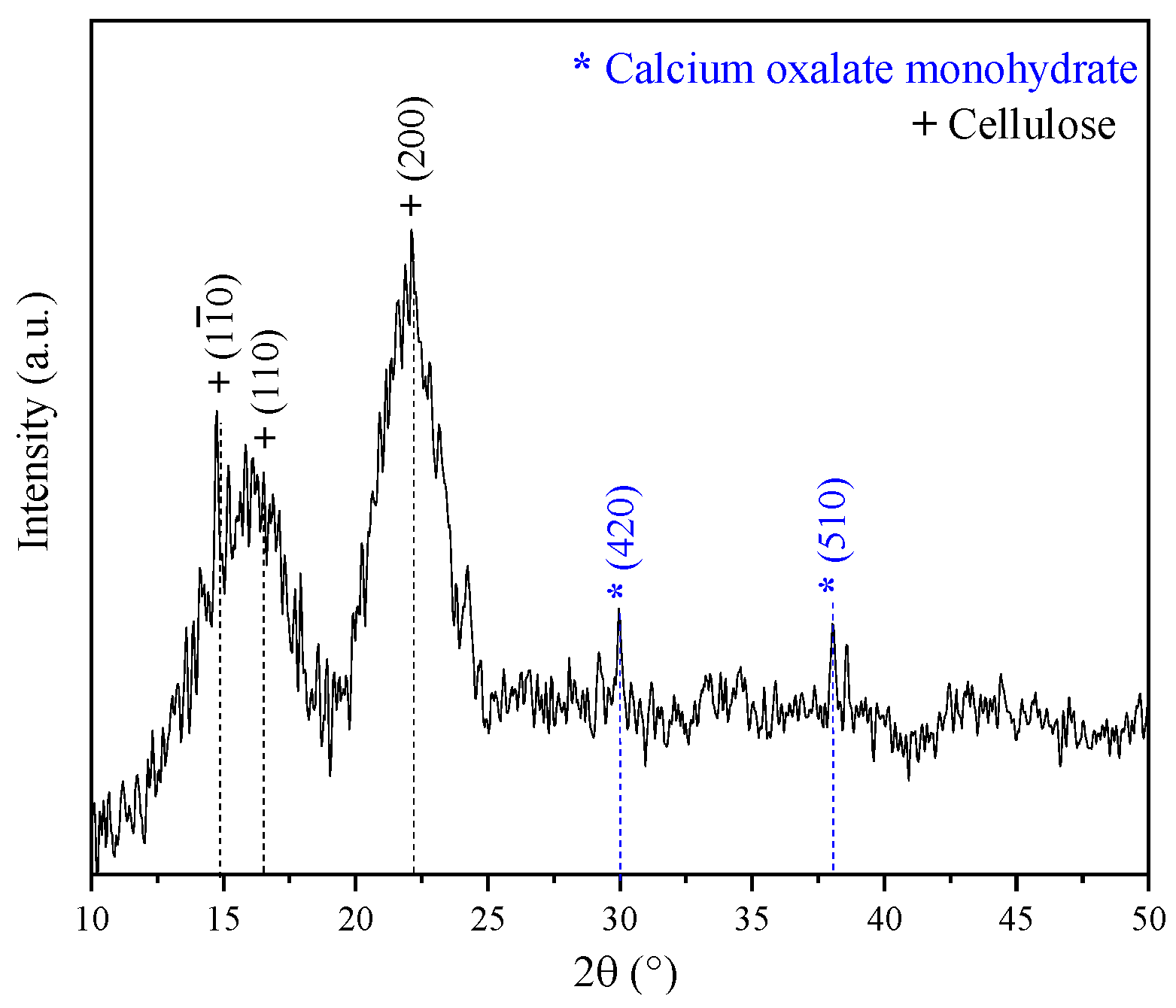
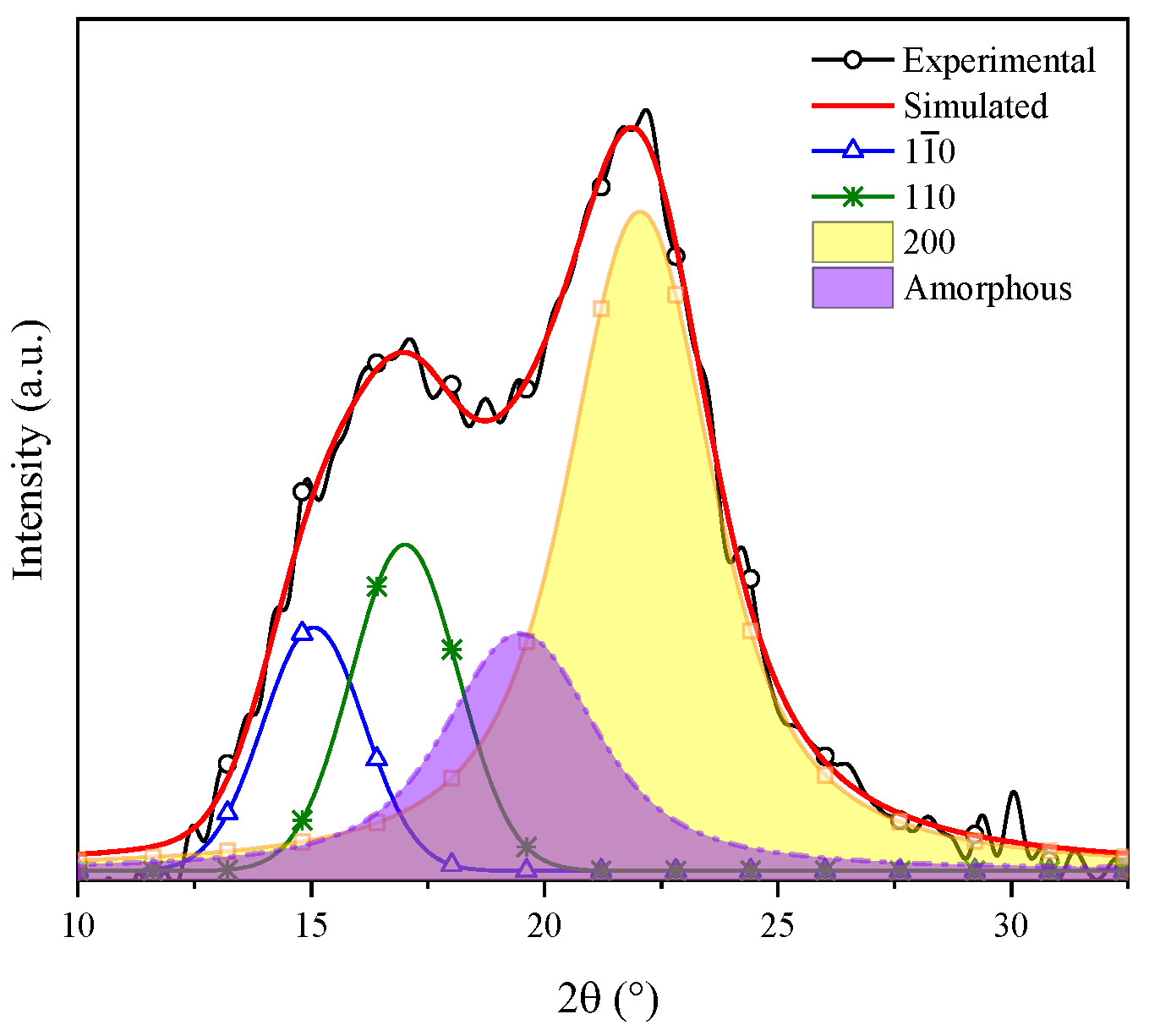

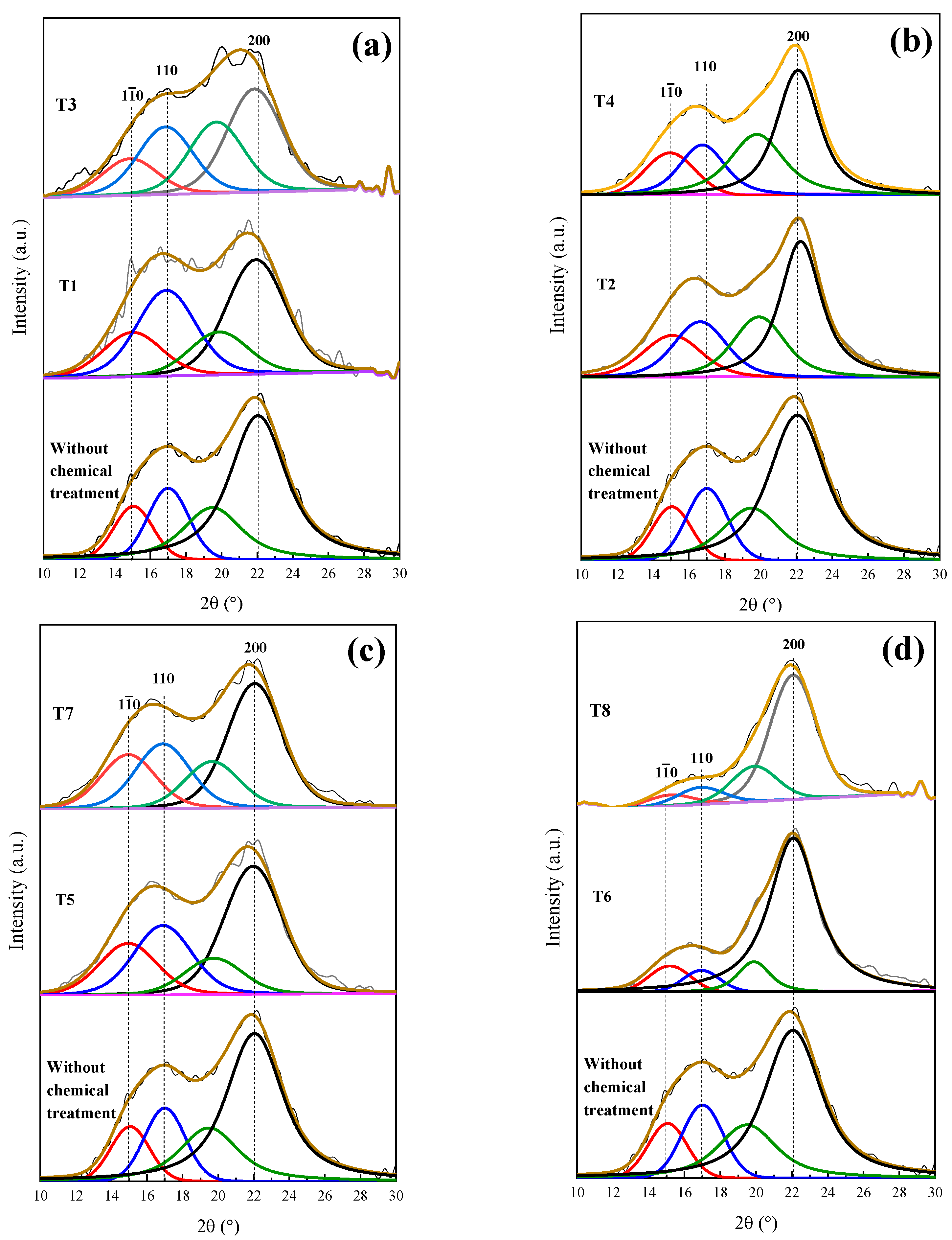
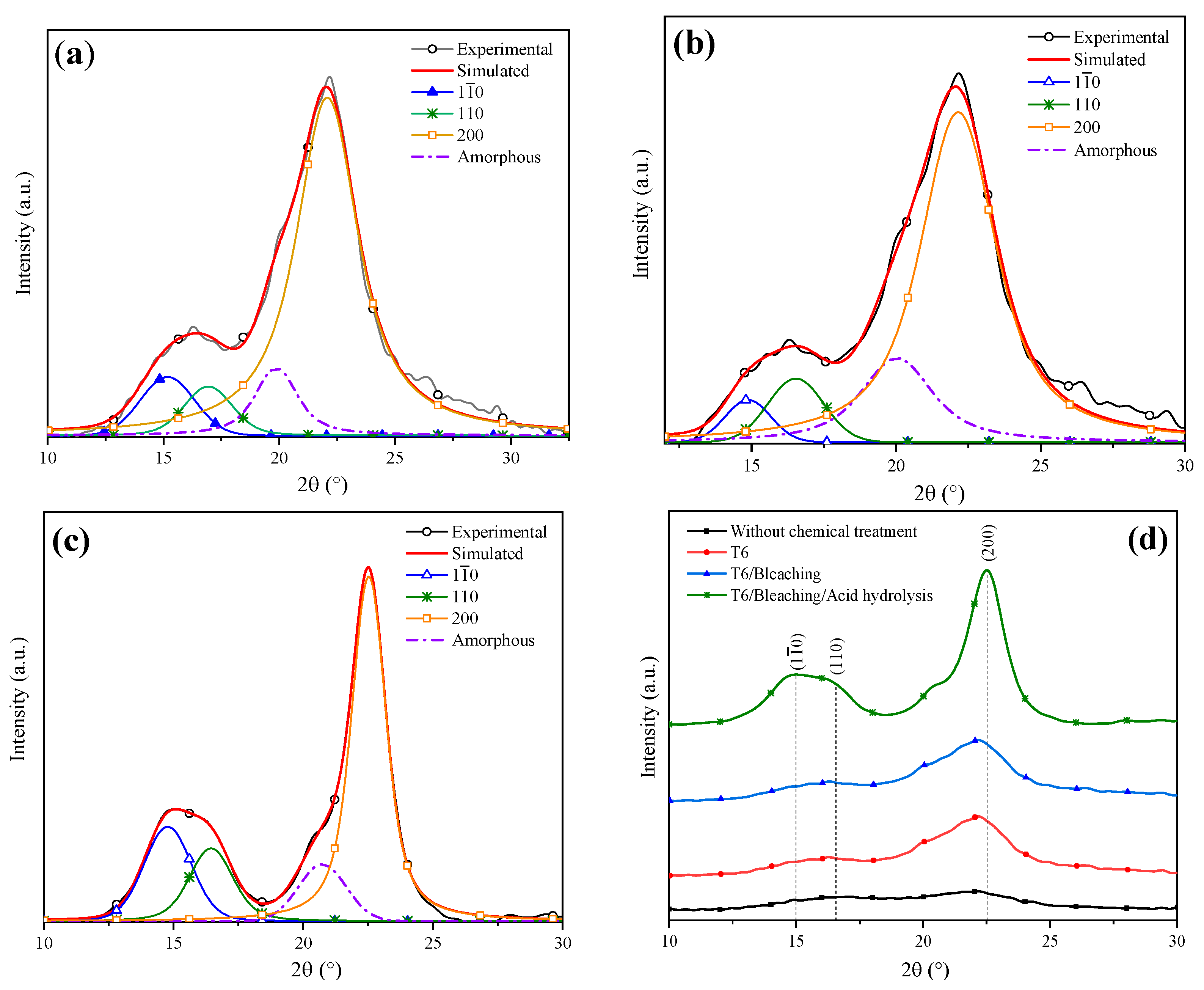


| Compounds | Experimentation | Borrelli et al. [45] | Pourfarzad et al. [47] |
|---|---|---|---|
| Moisture % | 8.32 ± 1.04 | 7.30 | 7.1 |
| Ash % | 7.83 ± 1.08 | 7.0 | 7 |
| Ethereal extracts % | 2.87 ± 0.93 | 2.2 | 2.2 |
| Crude fiber % | 18.07 ± 1.13 | 53.7 | 53 |
| Lignocellulosic Compounds of Coffee Pulp | Experimentation | Ballesteros et al. [39] | Reis et al. [48] | Collazo et al. [13] |
|---|---|---|---|---|
| Lignin % | 18.29 ± 0.98 | 23.90 | 53 | 23.2 |
| Hemicellulose % | 20.92 ± 1.49 | 12.04 | 18 | 18.2 |
| Cellulose % | 26.06 ± 0.83 | 39–10 | 22 | 35.4 |
| Treatment (T) | NaOH Concentration (wt.%) | Temperature (°C) | Time (h) | Lignin (%) | Cellulose (%) | Hemicellulose (%) |
|---|---|---|---|---|---|---|
| Without treatment | - | - | - | 18.29 ± 0.98 | 26.06 ± 0.83 | 20.92 ± 1.49 |
| 1 | 10 | 120 | 1 | 17.58 ± 1.52 | 28.16 ± 1.59 | 19.22 ± 1.08 |
| 2 | 20 | 120 | 1 | 15.49 ± 1.43 | 34.70 ± 1.29 | 18.11 ± 1.78 |
| 3 | 10 | 170 | 1 | 16.34 ± 1.97 | 29.92 ± 0.42 | 19.27 ± 0.67 |
| 4 | 20 | 170 | 1 | 15.33 ± 1.14 | 40.26 ± 0.99 | 17.47 ± 0.67 |
| 5 | 10 | 120 | 3 | 15.61 ± 1.70 | 37.92 ± 1.61 | 16.97 ± 1.68 |
| 6 | 20 | 120 | 3 | 13.58 ± 1.28 | 48.74 ± 0.53 | 15.49 ± 1.06 |
| 7 | 10 | 170 | 3 | 14.82 ± 1.35 | 40.69 ± 1.46 | 13.05 ± 1.22 |
| 8 | 20 | 170 | 3 | 13.64 ± 1.50 | 50.17 ± 1.78 | 13.64 ± 1.05 |
| Component | Lignin (%) | Cellulose (%) | Hemicellulose (%) | Crystallinity Index (%) | Average Crystal Size (nm) |
|---|---|---|---|---|---|
| Coffee pulp | 18.29 | 26.06 | 20.92 | 57.14 | 2.16 |
| T6 | 13.58 | 48.74 | 15.49 | 75.42 | 2.91 |
| Bleaching | 1.07 | 57.5 | 2.37 | 80.12 | 3.41 |
| Acid hydrolysis | 0.05 | 64.7 | 0.07 | 94.67 | 3.85 |
Disclaimer/Publisher’s Note: The statements, opinions and data contained in all publications are solely those of the individual author(s) and contributor(s) and not of MDPI and/or the editor(s). MDPI and/or the editor(s) disclaim responsibility for any injury to people or property resulting from any ideas, methods, instructions or products referred to in the content. |
© 2023 by the authors. Licensee MDPI, Basel, Switzerland. This article is an open access article distributed under the terms and conditions of the Creative Commons Attribution (CC BY) license (https://creativecommons.org/licenses/by/4.0/).
Share and Cite
Rodriguez-Quiroz, E.S.; Olivares-Xometl, O.; Santacruz-Vázquez, V.; Santacruz-Vázquez, C.; Arellanes-Lozada, P.; Rubio-Rosas, E. Production of Cellulosic Microfibers from Coffee Pulp via Alkaline Treatment, Bleaching and Acid Hydrolysis. Materials 2023, 16, 7607. https://doi.org/10.3390/ma16247607
Rodriguez-Quiroz ES, Olivares-Xometl O, Santacruz-Vázquez V, Santacruz-Vázquez C, Arellanes-Lozada P, Rubio-Rosas E. Production of Cellulosic Microfibers from Coffee Pulp via Alkaline Treatment, Bleaching and Acid Hydrolysis. Materials. 2023; 16(24):7607. https://doi.org/10.3390/ma16247607
Chicago/Turabian StyleRodriguez-Quiroz, Eliud S., Octavio Olivares-Xometl, Verónica Santacruz-Vázquez, Claudia Santacruz-Vázquez, Paulina Arellanes-Lozada, and Efraín Rubio-Rosas. 2023. "Production of Cellulosic Microfibers from Coffee Pulp via Alkaline Treatment, Bleaching and Acid Hydrolysis" Materials 16, no. 24: 7607. https://doi.org/10.3390/ma16247607
APA StyleRodriguez-Quiroz, E. S., Olivares-Xometl, O., Santacruz-Vázquez, V., Santacruz-Vázquez, C., Arellanes-Lozada, P., & Rubio-Rosas, E. (2023). Production of Cellulosic Microfibers from Coffee Pulp via Alkaline Treatment, Bleaching and Acid Hydrolysis. Materials, 16(24), 7607. https://doi.org/10.3390/ma16247607







